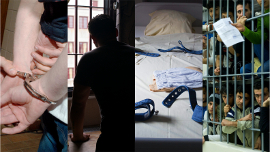The CPT’s delegation also examined the health care being provided to certain persons held at the Kyiv pre-trial establishment (SIZO) at the time of the visit, including Valeriy Ivashenko*, Yuriy Lutsenko and Yulia Tymoshenko. The Committee has expressed concern about the considerable delays observed in arranging specialised medical examinations for these persons outside the SIZO. The possible need for additional interventions to be explored in a hospital setting is also flagged.
Material conditions of detention were generally satisfactory in the police facilities visited. The CPT also gained a positive impression of the situation in the units for juveniles at the Kyiv and Kharkiv SIZOs; however, conditions of detention were extremely poor in many of the other units of these establishments. Numerous cells were in a poor state of repair and had only very limited access to natural light. In addition, a number of detention units in both of the establishments were severely overcrowded (e.g. at the Kharkiv SIZO, up to 44 prisoners in a cell measuring some 45 m²).
Further, the CPT has called on the authorities to put an immediate end to the practice, observed at the Secure Ward in the Kyiv Municipal Emergency Hospital, of handcuffing patients to hospital beds. The need to respect confidentiality of medical examinations is also emphasised.
In their response, the Ukrainian authorities provide information on steps taken or envisaged to implement the CPT’s recommendations. In particular, they state that the rights of persons in police custody have been reinforced with the adoption of the new Code of Criminal Procedure in April 2012. In addition, all police investigation departments have been instructed to ensure that detained persons effectively benefit from the right of access to a lawyer. As regards prisons, steps are being taken as a matter of priority to refurbish or reconstruct various SIZOs and, in particular, those in Kyiv and Kharkiv. Moreover, instructions have been issued to prohibit the handcuffing of patients to hospital beds and to guarantee the confidentiality of medical examinations as well as of related medical data.
The visit report and the response have been made public at the request of the Ukrainian authorities and are available on the CPT’s website http://www.cpt.coe.int* Valeriy Ivashenko was released in August 2012.



